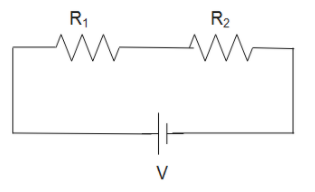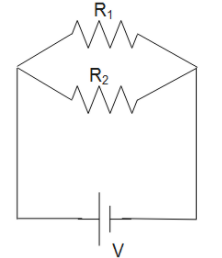
Out of two bulbs 50W and 100W, which one will grow brighter if (SAT) connected in series and when connected in parallel?
Answer
556.8k+ views
Hint: In this question, we use the basic relation between the current, voltage and resistance of series and parallel connection as well. We will also see a relation between power, current and voltage in these circuits. This will help us get the required result.
Formula used:
$R = \dfrac{{{V^2}}}{P}$
$I = \dfrac{V}{{{R_s}}}$
Complete answer:
As we know from Ohm’s law current I is inversely related to the resistance R of a circuit. So, here for the given rated voltage bulb, the resistance of the 50 W bulb will be more than that of the 100W bulb.
As resistance is given by:
$R = \dfrac{{{V^2}}}{P}$
The total current flowing in the circuit in series is given by:
$I = \dfrac{V}{{{R_s}}}$
Since the same current is passing through each bulb when connected in series, 50W bulb will glow brighter as power is given by the product of square of current and resistance, which is more in case of 50W bulb.
Also, when these bulbs are connected in parallel, 100W bulb will glow much brighter as power here is given as a product of square of voltage and resistance, which is more in case of 100W bulb.
If we take an example:
If the current applied is 5A and resistance is of 2ohm:
In series connection, the power will be more as compared to the parallel connection.
Therefore, we get the required answer.
Additional information:
We should know that in a series circuit, the output current of the first resistor flows into the input of the second resistor; so, the current is the same in each resistor. As shown is the figure below.

In a parallel circuit, all of the resistors are on connected together on one side and all the leads on the other side are connected together, as shown in the figure below:

In a circuit if the resistance is constant over a range of voltage, then I = V/R, can be used to predict the behavior of the material. This involves DC current and voltage, it is the same for the resistors. Further, a material obeys Ohm's law or does not obey; the resistance of the material can be described in terms of its bulk. The resistivity, and the resistance both, is temperature dependent. Over certain ranges of temperature, this temperature dependence can be predicted from resistance.
Note:
In series connection the resistances are directly added whereas in parallel connection resistance is added inversely. Internal resistance of a circuit refers to the opposition to the flow of current offered by the cells and batteries themselves thereby, resulting in the generation of heat. Internal resistance and resistance both are measured in Ohms.
Formula used:
$R = \dfrac{{{V^2}}}{P}$
$I = \dfrac{V}{{{R_s}}}$
Complete answer:
As we know from Ohm’s law current I is inversely related to the resistance R of a circuit. So, here for the given rated voltage bulb, the resistance of the 50 W bulb will be more than that of the 100W bulb.
As resistance is given by:
$R = \dfrac{{{V^2}}}{P}$
The total current flowing in the circuit in series is given by:
$I = \dfrac{V}{{{R_s}}}$
Since the same current is passing through each bulb when connected in series, 50W bulb will glow brighter as power is given by the product of square of current and resistance, which is more in case of 50W bulb.
Also, when these bulbs are connected in parallel, 100W bulb will glow much brighter as power here is given as a product of square of voltage and resistance, which is more in case of 100W bulb.
If we take an example:
If the current applied is 5A and resistance is of 2ohm:
In series connection, the power will be more as compared to the parallel connection.
Therefore, we get the required answer.
Additional information:
We should know that in a series circuit, the output current of the first resistor flows into the input of the second resistor; so, the current is the same in each resistor. As shown is the figure below.

In a parallel circuit, all of the resistors are on connected together on one side and all the leads on the other side are connected together, as shown in the figure below:

In a circuit if the resistance is constant over a range of voltage, then I = V/R, can be used to predict the behavior of the material. This involves DC current and voltage, it is the same for the resistors. Further, a material obeys Ohm's law or does not obey; the resistance of the material can be described in terms of its bulk. The resistivity, and the resistance both, is temperature dependent. Over certain ranges of temperature, this temperature dependence can be predicted from resistance.
Note:
In series connection the resistances are directly added whereas in parallel connection resistance is added inversely. Internal resistance of a circuit refers to the opposition to the flow of current offered by the cells and batteries themselves thereby, resulting in the generation of heat. Internal resistance and resistance both are measured in Ohms.
Recently Updated Pages
Master Class 11 Economics: Engaging Questions & Answers for Success

Master Class 11 English: Engaging Questions & Answers for Success

Master Class 11 Social Science: Engaging Questions & Answers for Success

Master Class 11 Biology: Engaging Questions & Answers for Success

Class 11 Question and Answer - Your Ultimate Solutions Guide

Master Class 11 Business Studies: Engaging Questions & Answers for Success

Trending doubts
What is meant by exothermic and endothermic reactions class 11 chemistry CBSE

10 examples of friction in our daily life

One Metric ton is equal to kg A 10000 B 1000 C 100 class 11 physics CBSE

Difference Between Prokaryotic Cells and Eukaryotic Cells

What are Quantum numbers Explain the quantum number class 11 chemistry CBSE

1 Quintal is equal to a 110 kg b 10 kg c 100kg d 1000 class 11 physics CBSE




